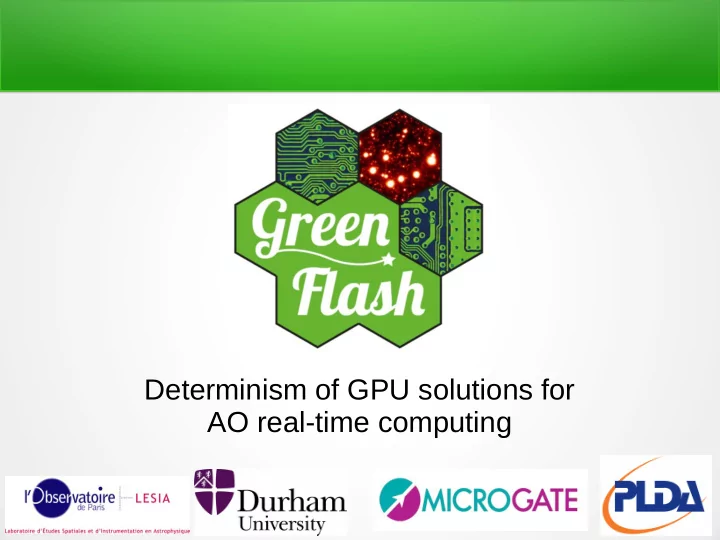

Determinism of GPU solutions for AO real-time computing
E-ELT ● AO RTC Architecture – Hard real time system (~1 kHz) – Big computation (5 TFLOPs) – Low latency – Maximum jitter : ~10%
Jitter ● Where is the jitter ? – Data transfer – Computation ● Jitter with standard transfer and computation Case Pipeline Time (jitter) (ms) 64x64 pixels 8x8 subpupils copy only 33 (35) copy + compute 96 (63) 240x240 pixels 40x40 subpupils copy only 204 (37) copy + compute 576 (57)
Data transfer ● Normal way – Main memory is a buffer – 2 copies by communication – CPU manage the communication ● GPUdirect RDMA (Remote Direct Memory Access) – No unnecessary copy – CPU only use for launching kernel CREDIT : NVIDIA
Transfer result ● GPUdirect – Reduce jitter during transfer to almost 0 – Reduces the transfer time by 2 ● But jitter still occurs during computations...
Computation ● Normal way – High jitter – Depends on CPU – Need a Real-Time OS Time (in µs) for 8k empty kernel call (average : ~6.5µs, peak : ~31µs) ● Jitter with RDMA transfer and standard computation Case Pipeline Time(jitter) (ms) 64x64 pixels 8x8 subpupils copy only 12 (12) copy + compute 69 (59) 240x240 pixels 40x40 subpupils copy only 112 (10) copy + compute 475 (50)
Perpetual kernel ● Pros – No scheduler – No additional cost Cpy Cpy Cpy Cpy Cpy – New features Comp Comp Comp Comp Comp ● Reduce computation Timeline for standard kernel call ● New synchronization features ● Cons – More complex implementation, Cpy Cpy Cpy Cpy Cpy test and debugging Comp Comp Comp Comp Comp – Hardware dependent Timeline for perpetual kernel call – Can't use any existing library Clock cycle count for 8k iterations
What's next ? ● Implementation of RTC with perpetual kernel ● Integration with frame grabber – Test with pixel generator – Integration on the optical bench – Full loop profiling ● Study on floating point precision to reduce the number of GPU
Recommend
More recommend